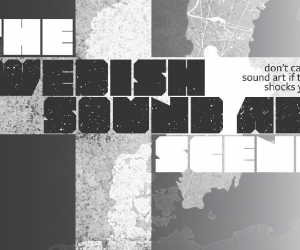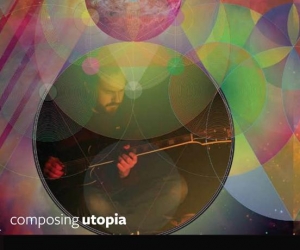
The slight, bright-eyed woman comfortably seated in her sunny Montreal studio is known as a musical beast. Hard to imagine. But the epithet is just one of several that contemporary recorder player and composer Terri Hron has earned—not on the expected grounds of virtuosity, but rather for her self-described unrefined and unconventional technique.
Yes, you’ve read correctly that this musical beast is a contemporary recorder player. The instrument found its way into Hron’s hands during public school in Edmonton. Lacking local music resources, she was forced to forage for further studies, mostly through lessons with touring musicians who passed through town. A life-changing encounter occurred with the arrival of the Loeki Stardust Quartet, a Dutch recorder ensemble, whose members encouraged her to attend early-music workshops in the USA and the Netherlands, which eventually inspired her to pursue graduate studies at the Amsterdam Conservatory.
A creative tightrope walker, Hron has a penchant for pushing creative practice into unfamiliar territories. From acoustic performance to computer-assisted practices, from notated music to instant composition, from the Renaissance to the avant-garde, and from Carnatic to Western traditions, Terri Hron takes many risks traversing musical boundaries.
Walter van Hauwe, one of Hron’s first teachers in Amsterdam, gave her permission to explore musically when he emphasized moving beyond standard early repertoire to contemporary works. “The recorder is fundamentally out of tune until blown into tune, leaving it very open to microtonality,” she explains. While her classmates were obsessed with playing in tune, Terri used this insight to push into challenging and sometimes uncomfortable areas. “I became intrigued by the attempts of composers like Ben Johnston and La Monte Young to expand sonorities through just intonation, and was attracted to the complexity of music by composers like Brian Ferneyhough,” she tells me. “I committed myself to learning complex works, suspending my disbelief in what could be expressed through them. In the end, I found the results unconvincing.”
Around the same time, Terri discovered Carnatic music, which resonated more with her growing interests. She focused her graduate work on contemporary music through non-Western techniques, which led to studies in South India. “The recorder lends itself to this style of music,” Terri reflects. “I was fascinated to learn from my new teachers, for whom a high level of tonal and rhythmic sophistication was deeply embedded. But I realized that it would take decades to internalize what they could hear and feel.”
A growing sensitivity to cultural appropriation and a natural restlessness led her back to the Amsterdam Conservatory. It was around this same time that Terri started experimenting with live electronics and real-time sound processing. “I wanted more volume, but also more timbral range,” she says. “I have these sounds in my mind, but they’re undefined. The possibilities of the mind are much greater than the physical world can allow. Technology can help me reach beyond.” From Hron’s perspective, she is never performing with a machine. Rather, she is collaborating with the creator of a particular environment. “These are very personal connections to creative ideas and expressions, to the idiomatic obsessions of other artists,” she asserts. Terri is clearly very deeply attracted to this notion. “I enjoy exploring, being part of the artistic process, connecting to these other creators’ personal expressions, seeking out the cohesion among musical ideas.”
The project that has brought together Terri’s influences and experiences is Bird on a Wire. From 2005 to 2008, she collaborated in musical experiments with six different composers—among them Canadians Peter Hannan and Laurie Radford—to create a set of works that position the recorder in a variety of electroacoustic conditions: signal-based processing, interactive improvisation environments, and real-time image to audio synthesis, just to name a few. Hron says she was inspired by the aviary idea of “trying to sing, or trying to become something that I should be. The wire simply references the electronics at play.”
Bird on a Wire, with which Hron toured North America and which she documented on CD in 2009, marks just one phase of an ongoing initiative. Terri is extremely interested in the collective learning that results from deeply collaborative creative processes. The current round of commissions—this time expanded to nine composers—places Terri in an eight-speaker, multi-channel environment. She likens the resulting complexity to birds flocking. “I’ll be immersed in this flock of loud speakers, just one sound of many. How will I fit into this world the composer is creating?” she asks. “I enjoy trying to understand each vision and helping to achieve it.”
She’ll give the project, Bird on a Wire 2: Flocking Patterns, its first flight on June 14, 2011, in New York City in a concert hosted by the Electronic Music Foundation. “The works are complex and require a more multifaceted role than before,” she is keen to point out. Other performance dates are in the works and she has a 5.1 surround recording in her sights. Both undertakings will need more time and effort. “You have to have faith in the idea and the bravery to see it through.”
On that note, the interview concludes. I can see she is getting fidgety. The initially welcomed distraction of our conversation is now a barrier to her getting on with her work.
FYI: Find out more about Terri Hron, and the latest installment of her Bird on a Wire project here.
Audio: Before Frozen Fog (2008). Composed for Terri Hron by Peter V. Swendsen. Performed by Terri Hron (recorder). Image: Terri Hron. Image by: Magda Bukowska.


